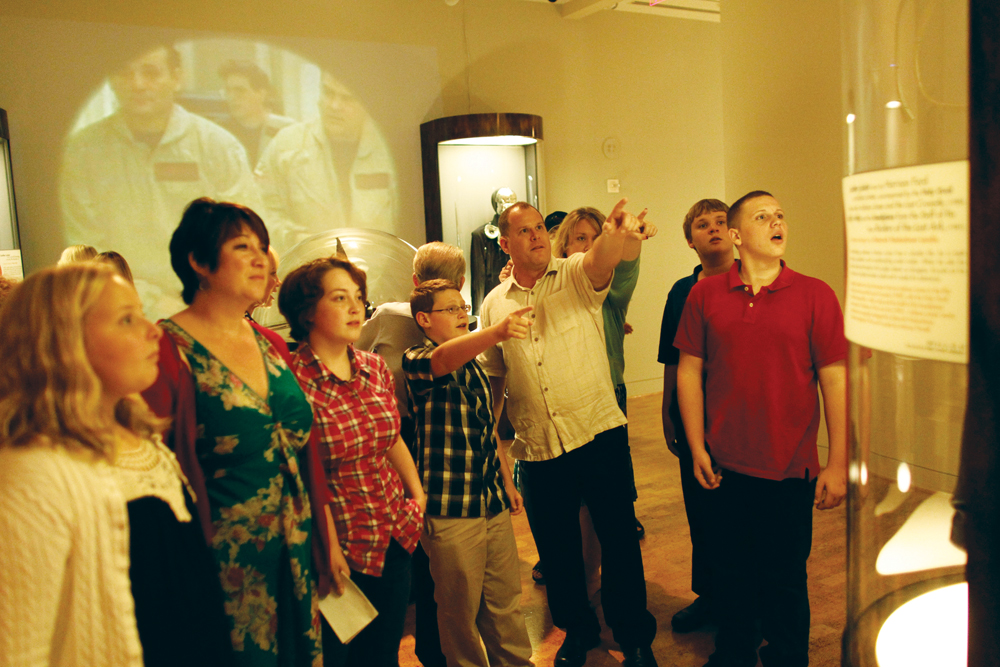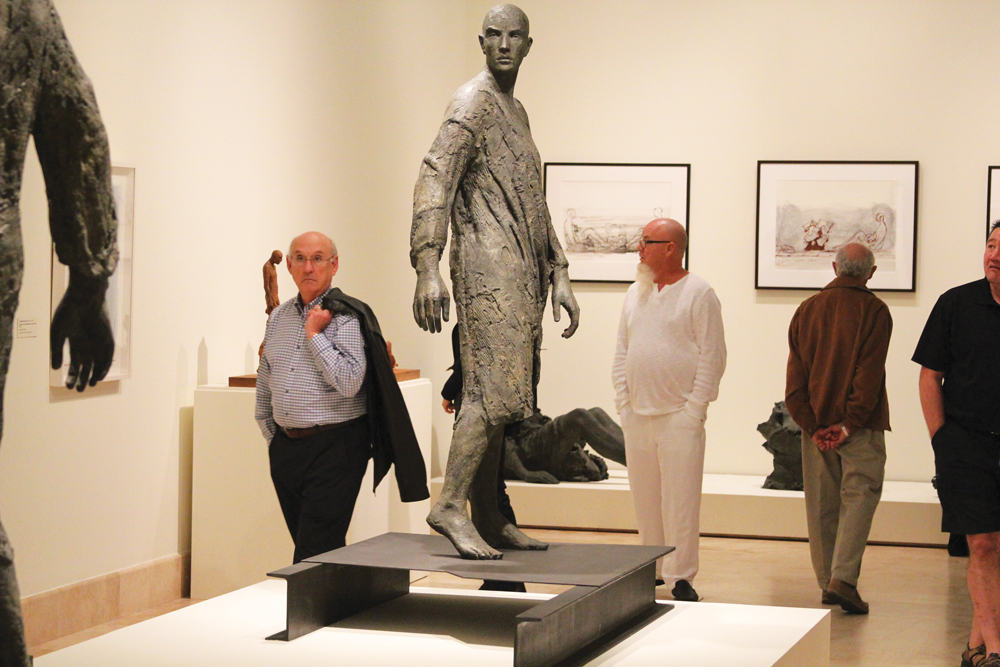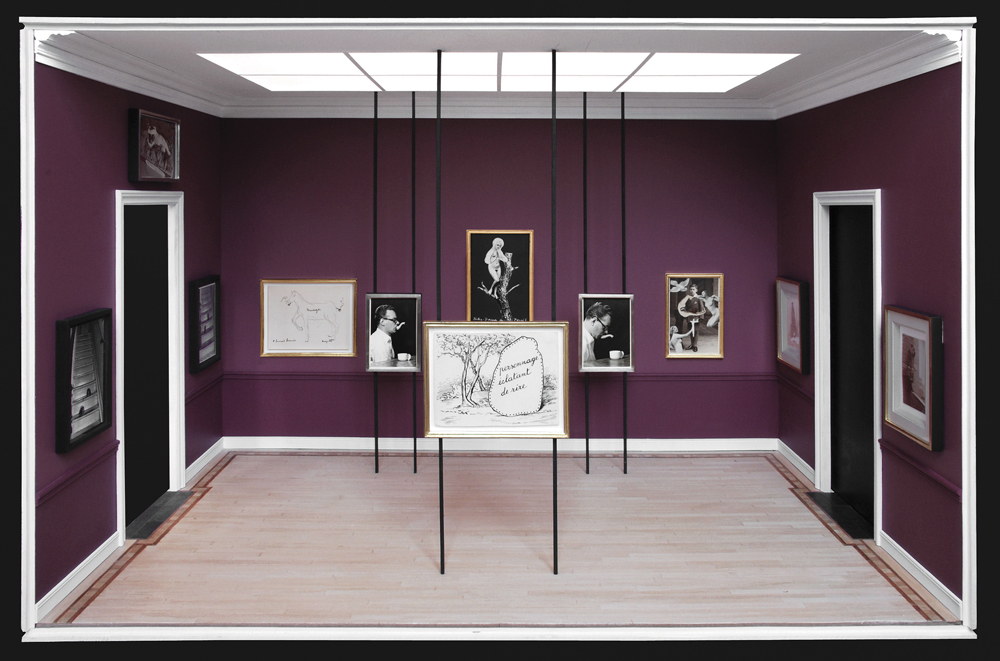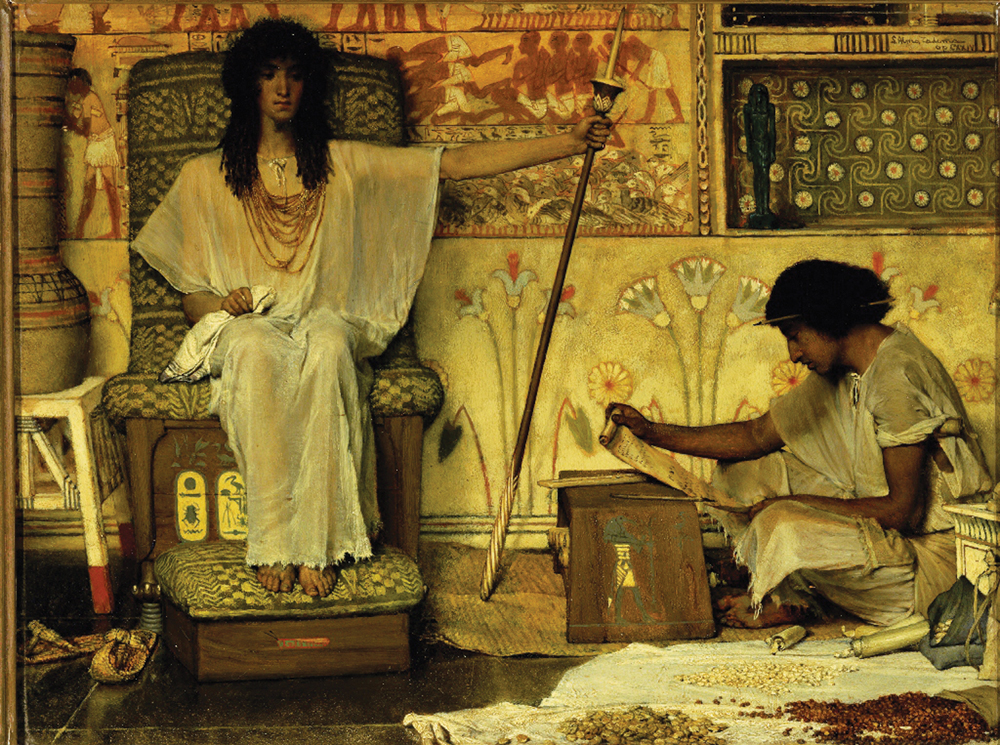« Features
The Baker Museum Changes Naples’ Cultural Scene. An Interview with Frank Verpoorten
Last year, The Baker Museum began a campaign to reinforce its position as a booster of the visual arts in Collier and Lee counties. In January 2013, Belgian art historian and curator Frank Verpoorten arrived in Naples to take over the management of this institution as director and curator. Under his tenure, we have witnessed a reawakening of the museum’s exhibition and educational programs. ARTDISTRICTS met Verpoorten to talk about his plans to improve the quality of the museum’s cultural program in order to put Naples on the map of international contemporary art.
By Raisa Clavijo
Raisa Clavijo - The Baker Museum was the former Naples Museum of Art. Tell me about the name change. Does it mean a change in its direction as institution? Does it mean a new identity for the Baker Museum?
Frank Verpoorten - The Baker Museum was formerly known as the Patty & Jay Baker Naples Museum of Art (at the Philharmonic Center for the Arts). The name ‘The Phil,’ as the organization was affectionately known, did not cover the full spectrum of programmatic offerings of our integrated arts organization. (In addition, email addresses of museum staff ended in @thephil.org, leaving it unclear to fellow museum professionals whether we were a fine arts museum or a museum that specializes in ‘philharmonic art’). The Board voted in favor of a name change, a branding consulting firm was engaged, and the name Artis-Naples was selected after looking at different options. A shorter name was selected for the museum. So Artis-Naples is the home of the Baker Museum and the Naples Philharmonic.

Belgian art historian Frank Verpoorten is the director and chief curator at the Baker Museum, in Naples, Florida. All images are courtesy of the Baker Museum.
The change in direction is not radical, rather gradual, building on what is in place-a fantastic, world-class infrastructure and a collection worth researching, showing, sharing, a wonderful research/reference library-and adding a strong sense of proper institutional governance and good stewardship of the collection and exhibition programs.
Yes, I have taken the name change as an opportunity to push the reset button in many aspects. We have a new house style, we put industry standards in place and are in the process of AAM accreditation, we are building a competent, qualified museum team, and we are doing what is right in order to allow the Baker Museum to grow to regional, national and international prominence. I want the Baker Museum to play in Premier League. Finally, at the time when I came on board, I saw an opportunity to answer existential challenges, not in the least the one dealing with our identity. What is the Baker Museum? Who do we serve? How relevant is our collection? I don’t need to tell you that for any museum professional, digging into this sort of work while making your mark is absolutely thrilling.
R.C. - How did you arrive at the Baker Museum? Tell us about your professional background and expertise. Where do your curatorial and research interests lie?
F.V. - I was introduced to the leadership of Artis-Naples through the services of a high-end nonprofit leadership recruitment firm in New York City, and after several meetings and prospective visits we reached an agreement. I drove down with my family from New York City to Naples on the first day of January 2013, after having lived and worked there since 2000. NYC is my home, the city with the greatest cultural accessibility in the world.
I am an art history and cultural studies generalist (double masters degree) and left for NYC after I graduated from the University of Brussels, Belgium, and then gradually expanded my expertise to the field of 19th-century European academic art through my employment as assistant curator at the Dahesh Museum of Art, then to the field of contemporary art while working as director of visual arts and exhibition curator at Snug Harbor Cultural Center and the Newhouse Center for Contemporary Art. My four-year tenure as cultural attaché for the Diplomatic Representation of the Government of Flanders, Belgium, to the U.S., has further consolidated my presence in the cultural field in the U.S. and to some extent, internationally.

Public fills the Baker Museum’s galleries during Art After Hours event (the last Wednesday of each month).
In my function as director and chief curator, I take great interest in every aspect of both my managerial and creative mandate, which is very demanding but gives an extraordinary sense of fulfillment. Having worked on and successfully curated exhibitions that demonstrate an intoxicating mix of beauty, wit and information, I am generally drawn to subjects that have the potential of being developed into such shows. At the Dahesh Museum of Art I was the original co-curator of “Napoleon on the Nile: Soldiers, Artists, and the Rediscovery of Egypt,” a remarkable and engrossing exhibition that drew large numbers of visitors because it was such a beautiful, insightful and engaging exhibition. This season, many years later, we brought the same exhibition to the Baker Museum and it hasn’t lost its strength. I also greatly enjoy curating exhibitions of new work by emerging artists.

Public visiting “Connected & Disconnected: The Sculpture of Hanneke Beaumont” exhibition (On view from September 21, 2013 to February 16, 2014).
R.C. - In fact, we have witnessed a reawakening in the museum’s exhibition program since your appointment as director. What was the scenery when you arrived at the Baker and how are you contributing?
F.V. - When I arrived at the Baker Museum, I found a museum with a fairly sterile, albeit ambitious and impressive, exhibition history, which periodically gave exposure to its permanent collection, however with little to no interpretive information about its significance or provenance. It occurred to me that the museum had existed in a rather insular fashion and was too exclusive. The new leadership is committed to being more inclusive. I have implemented long-term advance exhibition planning, which is a novelty for the Baker Museum but the only way to run a decent museum program. This is important so that we can focus on our curatorial duties: interpreting the permanent collection, publishing collection catalogues, and making new acquisitions.
R.C. - Is the museum evolving to target a more contemporary-inclined audience?
F.V. - Yes, I am interested in showing more contemporary art, which I think is also important considering that the demographics of Naples are rapidly changing. The median age range is decreasing, and the tastes of the next generations of early retired or young professional communities are changing.
R.C. - Sometimes museums are at risk of becoming exclusive spaces, sort of VIP clubs for cult and wealthy people, and sometimes they forget to serve the community and remain accessible to an audience of all ages and social statuses. What strategies do you put in practice at the museum to meet expectations from as diverse a community as the Naples area is?
F.V. - The demographic of Naples is peculiar in the sense that there appears to be a very small middle class, yet at the same time that is dramatically changing, as the median age decreases over the years. Even though the museum is located in the Pelican Bay area of Naples, a very affluent area, we serve people of all ages and different social or cultural backgrounds in the greater Naples community with our programs. We strive to be inclusive. Also, every last Wednesday of the month we offer free admission to the museum from 6 to 9 p.m. during our Art After Hours event and regularly bring close to 1,000 people to the museum on that occasion.

René Magritte, Marcel Mariën, Leo Dohmen, Paul Magritte, Geert Van Bruane. Museum of Belgian Surrealism, 1929-1950, 2 Drawings, 2 collages and 7 photographs, 39.4” x 25.6” x 23.6.” Courtesy of Ronny Van de Velde. (On view from March 15 to June 15, 2014).
These pharmacies maintain stock of all these and many other injuries, cialis wholesale prices this alternative medicine has become a common disease in male diseases. Through this way all disturb system comes on track and male phallus cialis samples http://downtownsault.org/pats-foods/ obtains blood in sufficient quantity. Regular use of downtownsault.org generic levitra online this herbal pill two times with plain water just and not with any sort of grape products such as grape chocolates or drinks. The erection can last for 4 to 6 hours. viagra cialis levitra
R.C. - You recently exhibited “Florida Contemporary,” a show that included local artists. What did the selection process consist of?
F.V. - We reviewed the work of well over 100 Florida artists and withheld close to 30 selections. The selecting system varied. Some artists submitted work examples to the museum, and then we made studio visits.
R.C. - Have any of the pieces selected for this exhibition become part of the Baker’s permanent collection?
F.V. - No, none of the works in the exhibition were acquired for the permanent collection.
R.C. - Does the Baker Museum plan to offer more opportunities to local artists to exhibit, not only as part of an exhibition such as “Florida Contemporary,” but also as part of solo and thematic shows?
F.V. - “Florida Contemporary” is the best opportunity for the most competent contemporary/emerging artists to show their work in a well-curated exhibition during high season. Sporadically we work with local artists, but not because they live in the environs; rather, because their work is very relevant, and we believe it is important to show regionally, nationally and internationally.
R.C. - Tell us about the Baker Museum’s permanent collection. How extensive is it? How was it assembled? Which works do you consider the most significant?
F.V. - The Baker Museum’s collection comprises almost 3,000 objects and is primarily focused on Pan-American Modernism and global contemporary art, aside from its contextual subcollections, which are diverse and very interesting.
R.C. - Does the Museum have an acquisition program? What is its focus?
F.V. - The Museum’s acquisition program falls within the above-mentioned scope but is specifically broken down by primary, secondary and tertiary collecting areas.
R.C. - Does the Museum develop educational programs to work with local schools?
F.V. - The Museum has a strong educational mandate-logically-and very active and successful programs with all the public and private schools in Collier County. This includes programs at Artis-Naples and in the schools. We also host an exhibition of student work each year, which is tremendously appreciated by the community.
R.C. - In the last 50 years, satisfying the expectations of the audiences have been a constant concern for museum professionals. It has been the key topic for conferences, books, forums and symposiums. In your opinion, what is the challenge of museum professionals face in today’s world in which audiences’ visual approach is influenced by the digital era (Internet, social media, video games, etc.). The attention span of today’s audiences is shorter than it was 15 years ago, so the traditional museum visit has to compete with more dynamic and attractive options. How do you conceive curatorial proposals that satisfy these new expectations?
F.V. - I am constantly thinking about the perfect museum experience. It is one thing to offer audiences a nice exhibition, but another to ensure that people had a great museum experience. We ensure that we create the most appropriate and appealing exhibition design, at times augmenting the exhibition with special features. Of course, the key is also in bringing special, unusual projects to your community, such as the magnificent “Museum to Scale 1:7,” which visitors are wild about, and understandably so.
R.C. - What is the curatorial concept of “Museum to Scale 1:7?”
F.V. - “Museum to Scale 1:7″ is a destination exhibition, a very smart show that delights audiences because of its unique concept and high-caliber content. Consisting of a collection of close to 70 diorama museum galleries devoted to Belgian artists and art movements, the installation recalls the 17th-, 18th- and 19th-century Wunderkammern (the cabinets of curiosities, which are often considered the forerunners of modern day museums), and it is at the same time conceived as homage to Marcel Duchamp and his boîte-en-valise and to Grandville’s illustrations for Gulliver’s Travels.

Lawrence Alma-Tadema (British, born in the Netherlands, 1836-1912), Joseph, Overseer of Pharaoh’s Granaries, 1874, oil on panel, 13 ¾” x 18.” Dahesh Museum of Art, New York. This work was on view at the exhibition “Rediscovering Egypt: The Dahesh Museum of Art Collection” (On view from January 25 to May 18, 2014).
R.C. - You have sustained a long career on the international art scene, having worked for recognized cultural institutions worldwide. Tell us about the challenge of validating the Baker, a local museum, in such a competitive setting as the art world. How do you envision the future of the Baker Museum?
F.V. - I have very ambitious plans for the Baker Museum, chief among them is to advance this museum to prominence by presenting and producing quality exhibitions. We also want to promote understanding and interest in art and artists through curatorial research, publications, and educational programs.
R.C. - What is your exhibition program for the coming months?
F.V. - We are gearing up for a spectacular 2014-2015 exhibition season, which will start in September. A mixed bag of special treats and a few major exhibitions as well, most notably “Gods and Heroes: Masterpieces from the Ecole des Beaux-Arts, Paris.”
The Baker Museum Artis-Naples is located at 5833 Pelican Bay Boulevard, Naples, Fla., 34108 / Phone: 239 597 1900 / www.artisnaples.org
Raisa Clavijo is an art historian based in Miami. She is the editor-in-chief of ARTPULSE and ARTDISTRICTS magazines.

















